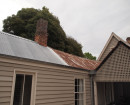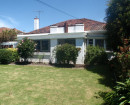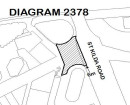Civic and Community Precinct
CAMBERWELL, BOROONDARA CITY
-
Add to tour
You must log in to do that.
-
Share
-
Shortlist place
You must log in to do that.
- Download report
Statement of Significance
HO506 Civic and Community Precinct, Camberwell
What is Significant
The Civic and Community Precinct encompasses Camberwell's Town Hall; Boroondara municipaladministration buildings; the Roman Catholic, Anglican and Methodist churches with their attendant housing and halls; Camberwell State School and Our Lady's Catholic parish school; and block of publictoilets. These buildings are set in or associated with substantial landholdings including public gardens, school playing grounds, gardens around clerical housing, a public bowling green and tennis courts attached to the Anglican Church. The street boundaries are Burke Road (west side), Inglesby Road (south side) and Camberwell Road (northeast side); the area is bisected from east to west by Reserve Road.
As the starting point of the Junction's commercial development and the city's civic development, this triangle of land has great historical significance to the City and, in its individual built components and their setting, aesthetic importance. Considered as a building group they are linked by their detached siting and civic/public scale and use (G Butler, Camberwell Conservation Study, 1991 and Lovell Chen 2008).
Specific buildings which contribute to the significance of the precinct are as follows:
Our Lady of Victories Catholic Church
Our Lady of Victories Catholic School
Our Lady of Victories Presbytery
St John's Presbytery
Public toilet
Camberwell Primary School
Camberwell Uniting Church
Former Wesleyan Manse
Camberwell Civic Centre
Camberwell Town Hall
Camberwell Municipal Offices
In addition to the buildings the open landscape and mature plantings provide an appropriate and important setting.
How is it Significant
The Civic and Community Precinct is historically, aesthetically and socially significant to the City of Boroondara
Why is it Significant
The Civic and Community Precinct is of major historical importance in the association of the original reserved land and related buildings with the early development and later growth of the former City of Camberwell. The precinct contains civic buildings, schools and churches all of which have been important in the growth and development of Camberwell and continue to be so in the new City of Boroondara. The precinct is of social significance as the focus of contemporary local governance and in continuing to play a significant role in the provision of places of education and worship for the local community. The civic hall in particular has been and continues to be a place used by the community for events, functions, and related activities. Aesthetically, the precinct contains buildings of a generally high level of individual significance, which both individually and as a group are of particular distinction within the local context. Their aesthetic significance is enhanced by their open setting and the associated landscape and mature plantings.
-
-
Civic and Community Precinct - Physical Conditions
The precinct encompasses Camberwell's Town Hall; Boroondara municipal administration buildings; the Roman Catholic, Anglican and Methodist churches with their attendant housing and halls; Camberwell State School and Our Lady's Catholic parish school; and block of public toilets. The remainder of the designated land is either for public gardens, school playing grounds, gardens around clerical housing, a public bowling green and tennis courts attached to the Anglican Church. The area is triangular in shape, excluding a corner immediately southeast of Camberwell Junction which has been taken over by a commercial premises. The street boundaries are Burke Road (west side), Inglesby Road (south side) and Camberwell Road (northeast side); the area is bisected from east to west by Reserve Road.
The civic and community use of this area began with the sale of land in the designated precinct area to the churches and municipal administration, between c1853 (first reversion to Crown land), 1859 (sale to the Catholic Church of land on Burke Road; Anglican Church land acquisition to Burke Road frontage) and 1861 (town common set aside for Boroondara Road Board). A cricket club occupied part of the area until 1914 when it moved further down Camberwell Road. A post office was at the Camberwell Junction corner, but has since been sold.5 Otherwise all the original users are still on the site. The post office was rebuilt in the 1960s, but that building is now occupied for commercial use, and a large office building was constructed alongside it at 250 Camberwell Road. These last two properties are excluded from the nominated precinct as they now serve a commercial rather than a civic or community purpose.
Residential buildings contributing to the precinct's heritage value include:
-The former Wesleyan Parsonage, 316 Camberwell Road, a progressive design for its period (c1890) by John Beswicke, the noted Hawthorn architect. It includes skilled Queen Anne and Japanese references, comparable with current Hyndman and Bates houses in the Camberwell area.
-The Catholic Presbytery, 548 Burke Road. Its first component was completed in 1891,6 and included free Romanesque and Queen Anne detailing. It was a progressive and imposing design for its period. A later portion was added around 1915-20, in general sympathy with the original building. It provides an imposing entry building at the southwest corner of the precinct.
.-The Anglican Vicarage, 552 Burke Road, a typical later 19th century house added to on its north side around 1925 by Louis Williams, who was at that time the leading Anglican Church architect in the country. Its extensions consolidated St John's role as a major Anglican church in the region, and accompanied the enlargement of St John's church to a new Williams design in 1925-6 (now replaced).
Of the three churches, the former Wesleyan at 310 Camberwell Road, now the Uniting Church, is original, completed in 1885, possibly to a John Beswicke design.7 It is a late example of High Victorian polychrome Gothic, with a hall addition of c1904 and a screen to Camberwell Road added in 1932-3. Our Lady of Victories Catholic Church at the Burke Road-Reserve Road corner replaced an earlier building of 1887 with an imposing and monumental free Romanesque church to a design by August Fritsch, then the leading Catholic Church architect in Melbourne who was about to embark on a series of large suburban churches through Melbourne suburbs.8 It is unusually rich in its use of stone and in its internal furnishings, and in its use of a dome, which linked free Romanesque with the other Catholic tradition of the Italian Renaissance. Its general approach and bearing continued with St Dominic's, Riversdale Road, East Camberwell, 1938-40, by Payne and Dale, and with Schreiber and Jorgenson's Xavier College Chapel in Barker's Road Kew (1928). St John's Anglican on Burke Road (1965-7) was a quite late Louis Williams design replacing his earlier 1925-6 church which was destroyed by fire.9 It approaches cathedral scale and rounds out the former Camberwell municipality's Anglican churches, all in the Arts and Crafts-modern Gothic tradition.10 The later annexe sustains Williams' brick coloration and usage and is set to one side immediately north of the church, so that it is legible as a separate building.
Local Government buildings (all at 8 Inglesby Road) include the Town Hall by James Gall, completed in 1891. This is a major suburban town hall design from the period, comparable with Beswicke's for Hawthorn, Crouch and Wilson's for Malvern and George Johnson's for Collingwood. Replacing an earlier Shire hall of 1871, this new design combined a rusticated Renaissance ground floor with an unusually stretched and mannerist upper level and a tower with modillions, deepened entablatures and a spectacularly stretched mansard roof. Later additions have been kept to the rear and sides of the building and have not been obtrusive in the general form facing Camberwell Road. Irwin and Stephenson's Municipal Offices, of 1924, are an elegant classical and Regency combination of a type also seen in Irwin and Stevenson houses.11 These compare with contemporary municipal offices in the same attenuated classical-regency style. The Civic Centre (1965-8), by the noted school and church architects Mockridge Stahle and Mitchell, was a temple-formed auditorium building similar in approach to the contemporary Dallas Brooks Hall in East Melbourne, and along with that building is the most impressive representative of the style in Melbourne.
The State School in Camberwell Road was originally built as a Common School to a Crouch and Wilson design in 1868, and retains some of that fabric. Its later 1886 frontage has polychrome and jerkinheaded gabling characteristic of the Henry Bastow period in government school design. It also has a striking infant school addition of 1909, with flamboyant Art Nouveau signage and a curved bay, and contemporary with the Public Works' fine Canterbury Primary School of the same period. Later linkages and extensions, from the 1920s and following, run through to Reserve Road but do not interfere with the Camberwell Road elevations of 1909. Its Catholic counterpart, Our Lady's School, has some 1904 components but gained its current size and Reserve Road frontage in 1923, possibly to Fritsch designs.12 Later additions have been in broad sympathy but kept to the rear of the Reserve Road site.
On the recreational sites the bowling pavilion has replaced an earlier building shown in 1904 site plans; it and the Camberwell Road toilet block both date from the 1950s. The toilet block, though altered, is the more interesting design, being cylindrical with glass brick walling in clinker brick.
Landscape and plantings
The precinct gains an equal part of its identity from those parts kept as parkland, gardens or planting areas. The Burke Road end of the precinct is effectively introduced by garden: at the southwest corner of the Catholic Presbytery, augmented by the plane trees along Inglesby Road. This is an extensive and long-standing garden, semi-public in use, with a mixture of cypress and mature deciduous trees along the Burke Road frontage and around the Church in the area separating it from the School. There is smaller scale garden planting at the entry ground in front of Our Lady's Church, at the Burke Road-Reserve Road corner. St John's Anglican Presbytery, across Reserve Road north of the tennis courts, is a dense mixture of plane trees and large evergreen shrubs. The other Burke Road frontages down to the Junction and around to the east elevation of 250 Camberwell Road are either built on or paved over, and this absence of a garden area is one reason the precinct excludes the Junction corner and 250 Camberwell Road. The park immediately east of 250 Camberwell Road is primarily a gently sloping lawn with a mixture of large mature trees and some small palms, and some of this foliage marks the garden areas in front of both the State School and the Uniting Church.
The parkland along the south side of Reserve Road is similar to that running through to Camberwell Road, being gently sloping lawn with mature trees, augmented by a cluster of native and deciduous trees in the otherwise asphalted Catholic School yard. Along Inglesby Road there are a mixture of eucalypts and plane trees, supplemented in effect by large trees spreading across Inglesby Road from its south side, just outside the proposed precinct. The original Inglesby Road planting appears to have been plane trees, formerly the standard Camberwell street tree, and in later years these have been supplemented by eucalypts in planned pairs or small groups.
Specialised recreation sites include the tennis courts to the immediate south of St John's Church, the school grounds of both Our Lady of Victories between Reserve and Inglesby Roads, the State School grounds south to Reserve Road, and the bowling green, now doubling as a netball or basketball court. The cricket ground has long moved elsewhere.
6 Initial dating sourced from its foundation stone. The additions appear in character with 1910-25 building fabric.
7 Given that Beswicke designed the Manse. Butler, in his Camberwell Conservation Study, 1991, noted Beswicke's reformist use of medieval styles when discussing 25 Alma Road Camberwell in his study of specific sites.
8 As with St Brendan's, 103 Wellington Street Flemington, 1923-5, Our Lady Help of Christians, 49 Nicholson Street Brunswick East, c. 1924, St Francis Xavier, 1087 Whitehorse Road Box Hill, 1926, Our Holy Redeemer, 4 Barton Street, Surrey Hills, remodelled c. 1933, and Our Lady of Good Counsel, Whitehorse Road Balwyn, c. 1937.
9 Author: interview with Louis Williams, 1977.
10 These include Ward and Carleton's St Paul's Canterbury of c. 1906, Rodney Alsop's St Mark's Burke Road, c. 1928, Gawler and Drummond's Holy Trinity Surrey Hills, c. 1926, and Williams' own St Dominic's East Camberwell, 1932-65. With Alexander North, Williams also designed St Mark's Church Hall in c. 1914. 5 Built around 1966-7 and replacing an earlier Post Office of c1889-90. It is now a furniture retail store.
11 Such as their house for the painter Edgar Fullwood at Mont Albert Road Canterbury, 1928. Similar approaches in housing came with Blackett, Forster and Craig's houses in the Yarrbat Avenue Balwyn and houses by Marcus Barlow and FDG Hawkins in central Camberwell. Houses by the latter two firms are illustrated in Barlow's Australian Homes, Melbourne, 1926.
12 Given that Frisch was designing Our Lady of Good Counsel's primary School in Deepdene at the roughly the same time
-
-
-
-
-
Rathmore; Rokeby
 Boroondara City
Boroondara City -
Stratford
 Boroondara City
Boroondara City -
Stratford
 Boroondara City
Boroondara City
-
-









